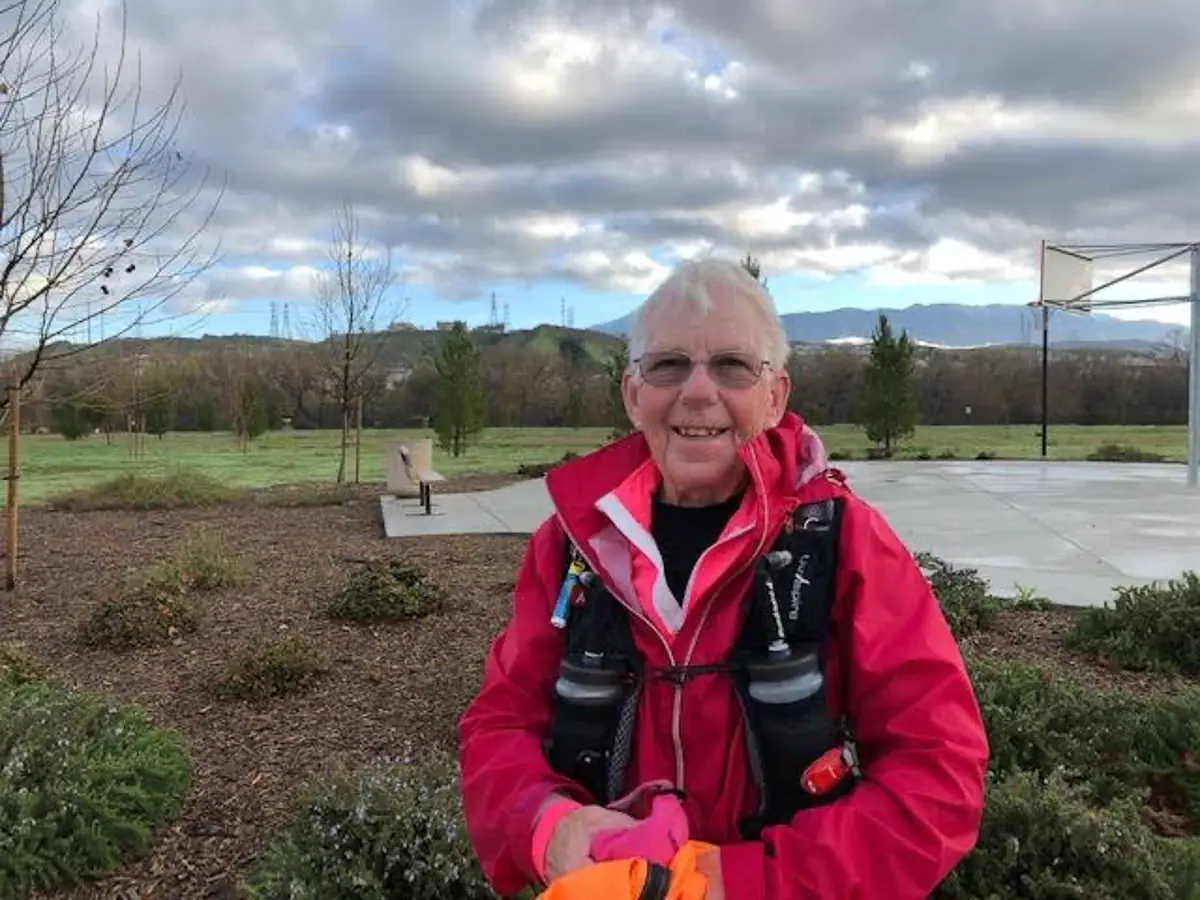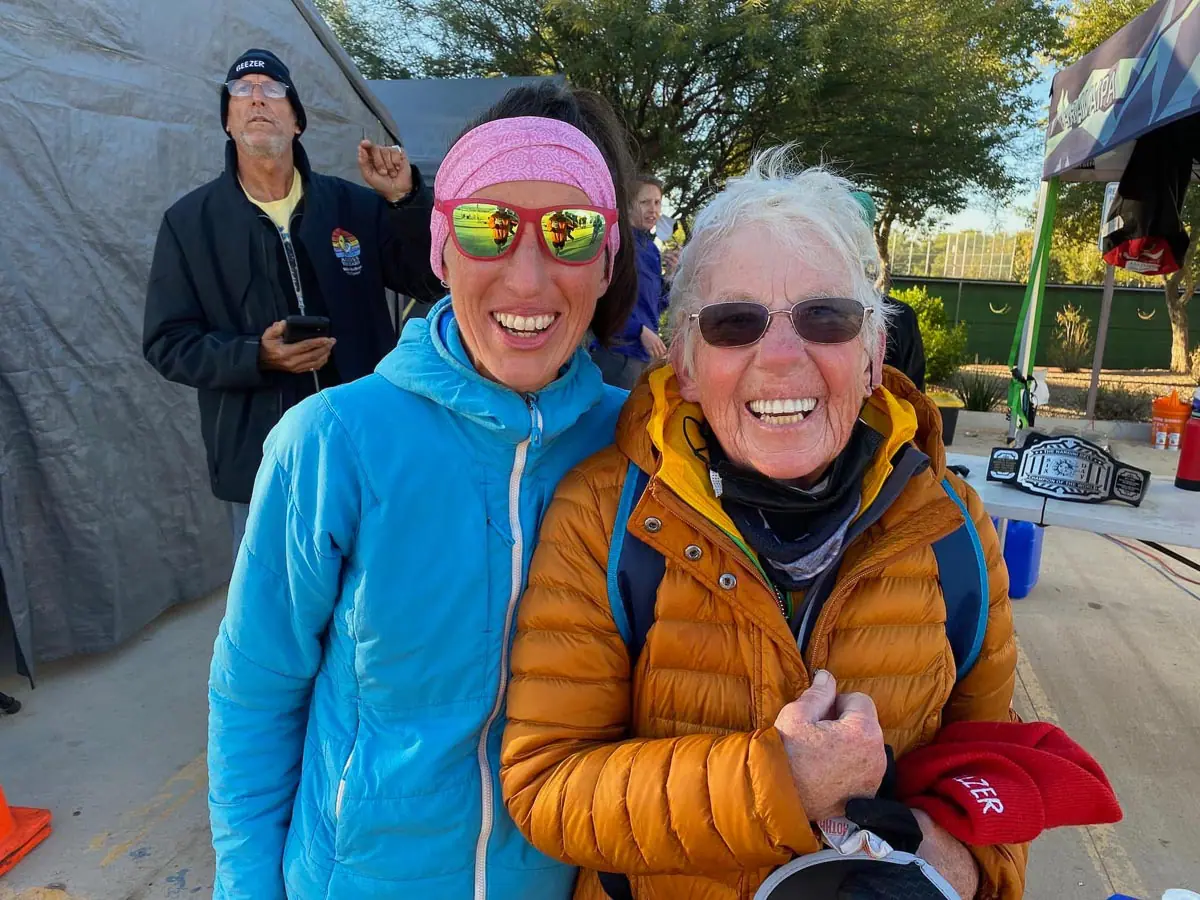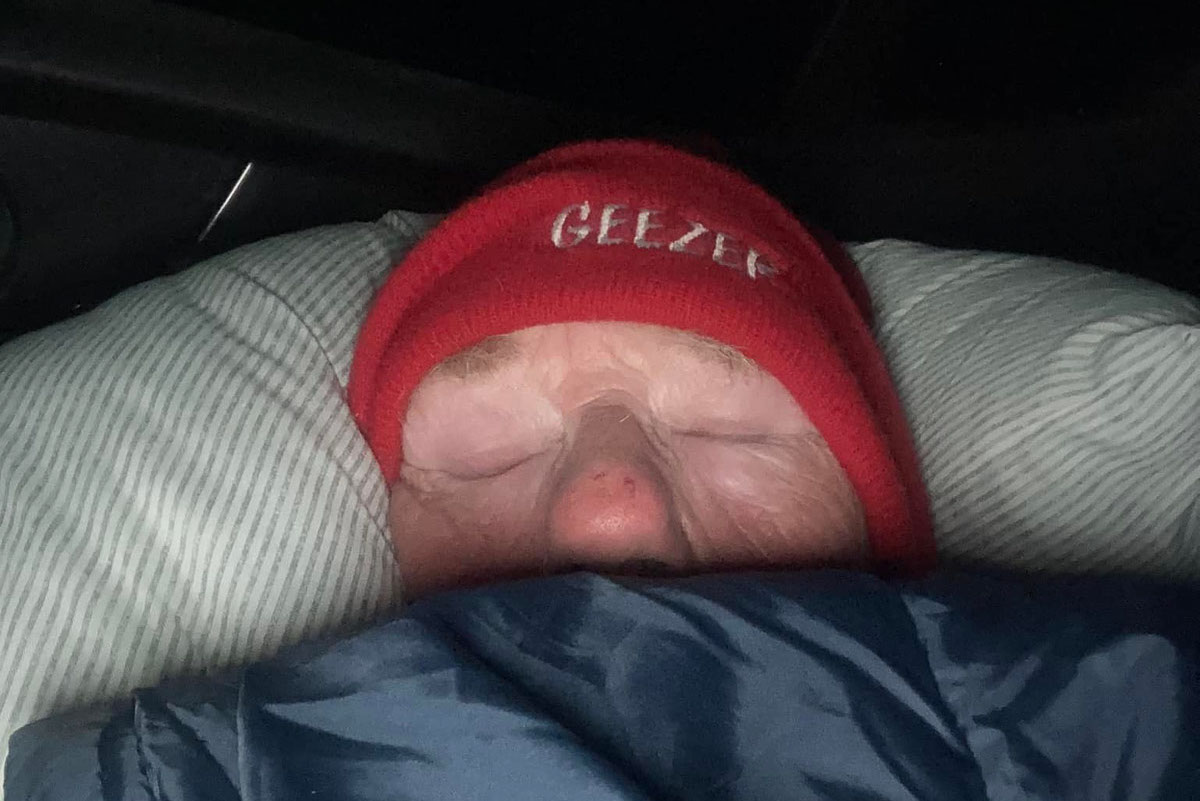A good friend of mine ran the 2021-2022 Across the Years 10 Day race this year. I’d write about how he circled a one-mile loop for 1o days straight spanning across the 2021 and 2022 calendar years, but he’s too young for the Age Old Runners spotlight. Happily, he texted me during the race with news that Dr. Terrie Wurzbacher was also competing. “Seventy something years old and she schooled pretty much all of us at the 10-day event,” he said.
Terrie is 73 years old and the Across the Years 10 Day was not her first multiday rodeo. In 2021, she also raced the Endless Mile 48 Hour and completed the Vol State 500k across Tennessee. In fact, since turning 65, Terrie has completed Vol State three times along with a slew of other fixed-time events. She also made it 716 miles into a transcontinental walk to honor military veterans in 2019 before stress fractures sidelined her.

Dr. Terrie Wurzbacher during her 2019 transcontinental trek. All images courtesy of Dr. Terrie Wurzbacher.
I messaged Terrie to ask for an interview. She told me she’d be happy to talk to me, but thought I should probably focus on somebody else. “I’m old and slow — nothing to write home about.” I assured her I very much wanted to talk with her, and told her how my friend had said she’d schooled everybody there. “He must have meant someone else, seriously. I only got 311 miles.”
When we finally talked, I was reminded of what author John Branch had written about climber Tommy Caldwell in his book Sidecountry: Tales of Death and Life from the Back Roads of Sports.
Tommy told him, “I have a very distinct goal all the time that I’m working toward, and I love the way it makes me live … Most of the days of the year I wake up with this on my mind, thinking, What am I going to do today to get one step closer? It gets me outside every day in the mountains in beautiful places, pushing myself. It makes me live at a higher level, having this as part of my life.” That’s how Terrie lives her life.
[Editor’s Note: The following interview has been edited for brevity and clarity.]

Dr. Terrie Wurzbacher (right) with Kaz Williams after finishing 311 miles at the 2021-2022 Across the Years 10 Day.
iRunFar: What drew you to running long distances?
Terrie Wurzbacher: I hated running up until I was 47 when I was forced into trying to run again. It’s a complicated story and kind of boring, but once I started running [in 1993], I became addicted. I just fell in love with it, and I thought if 26 miles was good, then 50 kilometers would be better. I think I did my first marathon in 1994. My first ultramarathon was a fat-ass 50 miler in North Carolina in 1994. I tried to do the 100 mile at the Umstead 100 Mile [in 1998], but only did 50 miles.
After that, I tried the Vermont 100 Mile, but I DNFed at 38 miles. I timed out of a few ultras like the JFK 50 Mile. I’ve always been slow, and obviously, as I’ve gotten older, I’ve gotten slower, which is why I pretty much have to stick to fixed-time events or Vol State now. I can still get in just under the wire at Vol State.
iRunFar: After Umstead in 1998, you didn’t start another ultra until you were 65 years old. What kept you away?
Wurzbacher: Life got in the way. I stuck to marathons. I didn’t think there were a lot of other ultras that I could finish. Then, I retired from the Navy [in 2004], and I put on a lot of weight. I just stopped running. I was going to run the New York City Marathon again in 2012, but it got canceled due to superstorm Sandy, so I ran the one in 2013. After that, I fell in love with Across the Years and Vol State. [Author’s Note: Terrie ran the 2012-2103 Across the Years Six Day. In 2014, she ran four fixed-time races, one 24 hours, two 72-hours, and one six-day. She DNFed Vol State.]
Those became the things I could do, especially being from Texas. I tried some other stuff, but I was too slow to do most of them. I got sick in 2016 with the flu and then with shingles. And then I had very severe post-shingles nerve pain. In 2017, I was hospitalized and I stopped running again. I could only walk after that.
My next event was in 2018, A Race for the Ages. [Author’s Note: At A Race for the Ages, runners over the age of 41 have the same number of hours to run as their age. All other runners have 40 hours to run. The runner who accumulates the most miles wins.] I was able to do Vol State again in 2018 too. I tried to do a transcontinental walk in 2019, but I only made it two states and 716 miles before I had stress fractures. I missed Vol State that year, and then the next year was the COVID-19 pandemic. So I’ll finally get to do Vol State again this year.
iRunFar: What is it about Vol State that brings you back again and again?
Wurzbacher: I have no idea. It’s in my blood. It started off being about whether I could do it. I DNFed my first time in 2014. In 2015, I finished. It’s just something that I have to do now. I love the people. In fact, I just finished writing the first draft of a book about Vol State as a metaphor for life. All my multiday events are training for Vol State now.

A poem-like update by race director Gary Cantrell, aka Laz, about Terrie Wurzbacher during the 2015 Vol State 500k.
iRunFar: This year you’ll attempt to do Vol State without a crew, or “screwed” as they say at the race?
Wurzbacher: I was crewed from the beginning in 2015, and then in 2018 and 2021, I started as screwed, but I ended up being crewed. The first year, there was no moon, and my headlamp sucked. The guy I was walking with initially had a good headlamp, but he wanted to move on because I was slow, and that was okay. But I knew there was no way I was going to be able to navigate at night [without him]. When I wrote that on Facebook, some of the people there rallied around me and got me a crew. I was able to finish, and it was a phenomenal experience.
The same sort of thing happened this year. I was determined to finish the race screwed, but halfway through, I got behind [the 10-day cutoff] because of the weather and the lighting. I was trying not to be stubborn about finishing screwed, so I asked one of the guys who had started and couldn’t finish if he would crew me, and he did. My goal was to finish at that point. I’m going to try screwed again this year and see what happens.
iRunFar: What are the differences between runners who focus on the longer fixed-time events and the runners who do Vol State?
Wurzbacher: Well, I don’t know that there are differences. I know that I’m different, and I didn’t realize that until I just did Across the Years. It is so boring. It’s just impossible. I don’t know how I managed 10 days of going around and around in a one-mile loop. I think the people who do fixed-time races are more goal-oriented.
I am much more adventure-oriented. And I think that’s what I love about Vol State. It’s just so unpredictable. Yet it’s a predictable unpredictability. The roads suck, but the people [are wonderful.] You just don’t know what you’re going to find there. Whereas at Across the Years, when you’ve been around the one-mile loop one time, you know exactly what you’re going to find for the next 10 days. Ugh.
iRunFar: You don’t sound like you want to do another 10-day race.
Wurzbacher: I probably will, but it was challenging, and it was challenging in a different way than I expected: it was boring.
iRunFar: That hadn’t been your experience at shorter fixed-time events?
Wurzbacher: No. I think one of the reasons why was, because this was the first time I had a [mileage] goal. Most of the time my goal is to see what I can do and have fun. I also really wanted to put into effect some of the mental toughness principles I have been studying to train for Vol State. I was able to do some of them, but that went out the door real early.
During the first five days, I was in pretty bad pain, and I almost quit. I kept packing up my tent and putting things in my truck. But I kept going, and I’m proud that I continued. The pain went away, fortunately.
iRunFar: Has it been your experience that pain goes away over time in a multi-day event?
Wurzbacher: That’s very interesting you should ask that. No. And this was a different kind of pain. This was reminiscent of the nerve pain I had after I had shingles. It wasn’t exactly like that, but it was similar.
I just kept thinking back to Vol State. There, if you get a bad blister on day one or two, by the time day six or seven comes along, you may have blisters, but they’re new blisters. The other ones have healed up. So I just kept saying, “I just want to go and see what tomorrow brings. If it’s like this, I can handle it. If it’s worse, I can stop for a day, or I can drop completely.”
I was just really trying to live in the moment, one day at a time. I didn’t know what was going to happen, but [it really helped] having had that experience at Vol State where things heal up and other things break. Ten days is really a lot longer than people realize.
iRunFar: How do your feet hold up over 10 days?
Wurzbacher: My foot is a problem. I have a big bunion and trying to get shoes that are wide enough is a problem. Fortunately, I had six different kinds of shoes with me at Across the Years, and I switched them out, and I finally found one that worked. But I also tape my feet. They’re like mummies, so I rarely have any blisters. I screwed that up at Vol State last year, but I had no blisters at Across the Years. Just the bunion was a problem. Plus, when you get older, you lose the fat pads on the bottom of your feet, so it feels like you’re actually walking right on the ground. The lack of cushioning makes it uncomfortable, but there isn’t much you can do about that.
iRunFar: Do you write race reports?
Wurzbacher: I wrote one in 2015 for Vol State. Most of the time I don’t write real race reports because they’re boring to other people. My race report for 2021’s Vol State is the book I’m writing. I finished the first draft the day before I left for Across the Years, and now I’m trying to get started on editing. I hope to get it finished and self-published before this year’s Vol State, so I can take some to give to people. It’s already 450 pages, so there’s a lot of editing.
iRunFar: What will your training look like between now and Vol State in July?
Wurzbacher: That’s something I’m still trying to work out. I don’t think I did it right last year. I’ll give myself another week of recovery from Across the Years, and then I’ll start building up with one really long walk a week, then two, then three.
iRunFar: How much mileage do you cover weekly?
Wurzbacher: That varies. When I did the Great Virtual Race Across Tennessee, I was doing maybe about 100 miles a week. Now it just depends. I didn’t really train for Across the Years. After Vol State in July, and the Endless Mile 48 Hour in October, I just walked a minimum of six miles a day.
iRunFar: Do you do any ancillary training to support your walking?
Wurzbacher: I really need to go back to weightlifting. I’d started lifting weights again at home before Across the Years, but I need to restart that to get more upper body strength before Vol State.
iRunFar: Will you try to walk across the United States again?
Wurzbacher: Yes. I think I’ll probably do it next year. I’ll be 74.
iRunFar: Why do you think many older ultrarunners stop racing?
Wurzbacher: I think sometimes it’s a physical thing. I also think there aren’t enough races [with achievable cutoffs] with the exception of these fixed-time events.
iRunFar: I wonder if there will be pressure to have more generous cutoffs as the ultrarunning community ages.
Wurzbacher: I hope so.
iRunFar: What else do you want people to know?
Wurzbacher: It’s not about the miles. It’s about the people that you see and meet. It’s about the camaraderie and just getting out there and not giving up on life. If you just don’t give up, you find out that there really is more. It’s not about the miles, it’s about what’s inside of you and what you have to give to others.
2021-2022 Across the Years 10 Day Age Group Results
Here are the age-group winners from the 2021-2022 Across the Years 10 Day, including the winners’ names and the number of miles they ran during the 10-day race.
Women
- Women’s 45-to-49 age group winner: Kaz Williams, 420.150 miles
- Women’s 50-to-54 age group winner: Van Phan, 603.507 miles
- Women’s 55-to-59 age group winner: Juda McGannon, 33.528 miles
- Women’s 65-to-69 age group winner: Janice Moyer, 183.357 miles
- Women’s 70-to-74 age group winner: Marie Boyd, 401.290 miles
- Women’s 75-to-79 age group winner: Edda Bauer, 440.057 miles
Men
- Men’s 45-to-49 age group winner: Steven Smith, 420.150 miles
- Men’s 50-to-54 age group winner: Arun Bharjwaj, 443.200 miles
- Men’s 55-to-59 age group winner: Karl Michel, 320.613 miles
- Men’s 60-to-64 age group winner: John Gessler, 475.681 miles
- Men’s 65-to-69 age group winner: Peter Coury, 100.584 miles
- Men’s 70-to-74 age group winner: Bobby Keogh, 254.604 miles
- Men’s 75-to-79 age group winner: Bill Dickey, 92.202 miles
Call for Comments
- Do you have a story about Terrie Wurzbacher? Leave a comment to share it!
- Wow, running 100-milers is one thing, but these super-long efforts are a whole ‘nother beast. Have any of you done Vol State or other cross-state or multiday events?


